This overclocking evaluation is the fourth of our Pascal TITAN X series. After introducing it ten days ago, we compared it with the GTX 1080 and found that the TITAN X was generally 20-30+% faster. Then we compared the last generation 28nm Maxwell TITAN X with the new 16nm Pascal version and found that the Pascal TITAN X is at least 60% faster. Now we want to overclock the TITAN X as far as we can to see how well it scales with 25 games. The new TITAN X is Nvidia’s fourth GeForce GPU based on 16nm Pascal architecture. It is much faster than the GTX 1080 which was until recently, the world’s fastest video card. The TITAN X is premium-priced at $1200, and it is also a hybrid card that is well-suited for Single Precision and Deep Learning compute programs.
The new TITAN X is Nvidia’s fourth GeForce GPU based on 16nm Pascal architecture. It is much faster than the GTX 1080 which was until recently, the world’s fastest video card. The TITAN X is premium-priced at $1200, and it is also a hybrid card that is well-suited for Single Precision and Deep Learning compute programs.
Instead of repeating all of the same information in our TITAN X introduction, we are instead going to highlight its specifications. The TITAN X is based on GP102 with a total of 3584 CUDA cores and it comes equipped with 12GB of GDDR5X for scientific applications and also for extreme resolutions in gaming. The TITAN X also features 11 TFLOPs FP32 Peak Single Precision performance and also has a new INT8 instruction set for deep learning inference. The TITAN X is still a gaming card, and it supports the same features of the other Pascal GPUs. Pascal delivers high clock speeds while using relatively little power – the GeForce TITAN X runs over 1.5 GHz with a TDP of 250W. 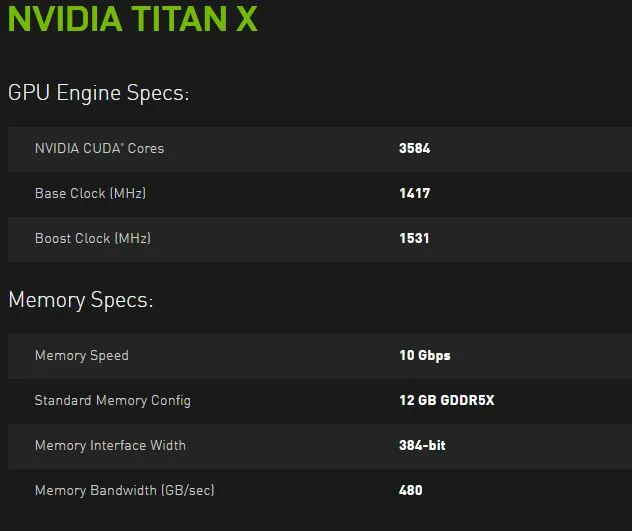
We received a TITAN X for evaluation from Nvidia together with a WQHD 34″ 3440×1440 ACER Predator X34 (21:9) G-SYNC display. Popularly called “2K”, super-widescreen WQHD has been added to our standard 3840×2160 and 2560×1440 benching resolutions instead of 1920×1080 as it is meaningless for powerful cards such as the TITAN X 
Our testing platform is Windows 10 Home 64-bit, using an Intel Core i7-6700K at 4.00GHz which turbos to 4.4GHz for all cores as set in the ASRock Z7170 motherboard’s BIOS, and 16GB of G.SKILL DDR4 at 3000MHz. The settings and hardware are identical except for the TITAN X clocks being tested. We are featuring all 25 games of our benchmark suite, and we are also including four DX12 games – Ashes of the Singularity, Hitman, Rise of the Tomb Raider, and Total War Warhammer – plus Futuremark’s recently released DX12 benchmark, Time Spy.
How well does the TITAN X Overclock?
The TITAN X is a 12-billion transistor 250W TDP chip which should tend to overclock less than the smaller and lower-TDP GPUs of the Pascal family. We are going to look the performance of the stock TITAN X compared with it overclocked as far as it can go with up to 100% fan speeds using MSI’s latest beta version of Afterburner. We are also using a new feature recently added to BTR’s reviews with this TITAN X series – percentages of difference between the stock and overclocked results.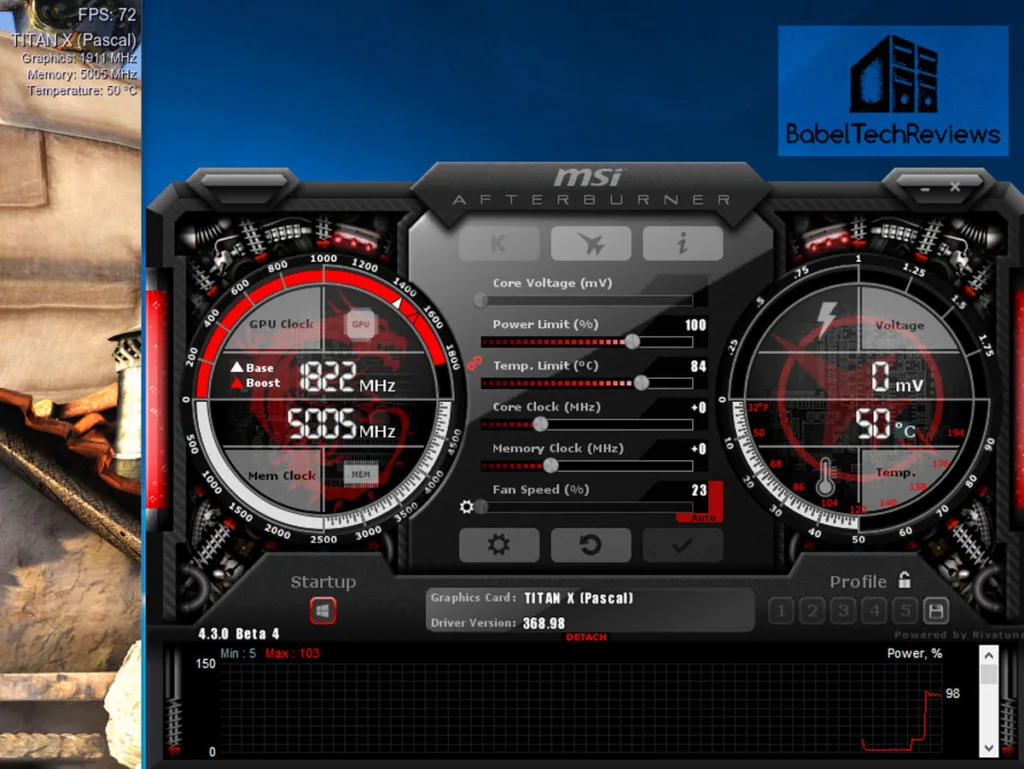
We are going to concentrate only on overclocking the TITAN X. AMD’s flagship, the Fury X, is slower than the GTX 1080 and in our ongoing tests, it has failed to win a single benchmark. The TITAN X is in a class even higher than the GTX 1080, and it might be better to compare the TITAN X performance with Fury X CrossFire or with GTX 1070 SLI. AMD is pinning their hopes on next year’s big chip, Vega.
Let’s check out the test configuration.
Test Configuration – Hardware
- Intel Core i7-6700K (reference 4.0GHz, HyperThreading and Turbo boost is on to 4.4GHz; DX11 CPU graphics).
- ASRock Z7170M OC Formula motherboard (Intel Z7170 chipset, latest BIOS, PCIe 3.0/3.1 specification, CrossFire/SLI 8x+8x)
- G.Skill Ripjaws V 16GB DDR4 (2x8GB, dual channel at 3000MHz)
- TITAN X (Pascal), 12GB, stock clocks and overclocked, supplied by Nvidia
- 2TB Toshiba 7200 rpm HDD
- EVGA 1000G 1000W power supply unit
- Thermaltake Water2.0, supplied by Thermaltake
- Onboard Realtek Audio
- Genius SP-D150 speakers, supplied by Genius
- Thermaltake Overseer RX-I full tower case, supplied by Thermaltake
- ASUS 12X Blu-ray writer
- Monoprice Crystal Pro 4K (3840×2160)
- ACER Predator X34 – 34″ WQHD 2K G-SYNC display (3440×1440), supplied by Nvidia
Test Configuration – Software
- Nvidia’s GeForce 368.98 (TITAN X launch drivers) were used.. High Quality, prefer maximum performance, single display.
- VSync and G-SYNC are off in the control panel.
- AA enabled as noted in games; all in-game settings are specified with 16xAF always applied
- All results show average frame rates including minimum frame rates shown in italics on the chart next to the averages in smaller font. Percentage increases are shown in a separate column.
- Highest quality sound (stereo) used in all games.
- Windows 10 64-bit Home edition, all DX11 titles were run under DX11 render paths. DOOM is run under the OpenGL API. Our four DX12 titles are run under the DX12 render path. Latest DirectX
- All games/SW are patched to their latest versions at time of publication.
- MSI’s latest beta version of Afterburner was used to set the Power and Temperature targets to their maximum.
- Unigine Heaven 4.0 benchmark
The 25 PC Game benchmark suite & 2 synthetic tests
Synthetic
- Firestrike – Extreme & Ultra
- Time Spy DX12
- Crysis 3
- Metro: Last Light Redux (2014)
- Middle Earth: Shadows of Mordor
- Alien Isolation
- Dragon’s Age: Inquisition
- Dying Light
- Grand Theft Auto V
- ProjectCARS
- the Witcher 3
- Batman: Arkham Origins
- Mad Max
- Fallout 4
- Star Wars Battlefront
- Assassin’s Creed Syndicate
- Just Cause 3
- Rainbow Six Siege
- DiRT Rally
- Far Cry Primal
- Tom Clancy’s The Division
- DOOM (*OpenGL)
- Mirror’s Edge Catalyst
DX12 Games
- Ashes of the Singularity
- Hitman
- Rise of the Tomb Raider
- Total War: Warhammer
Nvidia’s Control Panel settings:
We used MSI’s Afterburner to set the TITAN X Power and Temperature targets to their maximum.
Calculating Percentages
There are two methods of calculating percentages. One is the “Percentage Difference” that we used to compare the GTX 1080 versus the TITAN X, and the other is “Percentage Change” which we are using now to show the performance improvements of the overclocked Pascal TITAN X over its stock clocks.
For the percentage change, we mean the increase in frame rates between the stock and the overclocked TITAN X, divided by the absolute value of the original stock frame rate in fps, multiplied by 100.
Percentage change may be expressed by the algebraic formula where “V” is Value: ( ΔV / |V1| ) * 100 = ((V2 – V1) / |V1|) * 100
Let’s get to our overclocking methods, and finally to the 26-game overclocked results.
Overclocking with MSI’s Afterburner
Afterburner is a free MSI utility which offers these very useful features:
- Overclocking tools for Nvidia and AMD cards
- Hardware monitoring
- Overvoltaging controls (which are not supported yet for the TITAN X)
- Triple Overvoltage which provides precise control of the Core, Memory and PLL voltages (unsupported for TITAN X)
- Custom Fan profiles
- FPS in-game counter for DX11/OpenGL games
- 64-bit support/Custom Skins/Multi-language support/stability testing/video capture/mobile apps
Make sure to check out our GTX 1060 overclocking evaluation. We used EVGA’s PrecisionX OC which does not currently load for the TITAN X, but the method of manual overclocking is similar for all Pascal-based video cards whether you use EVGA’s tool or MSI’s Afterburner.
We found a completely smooth experience using Afterburner to set the TITAN X clocks. Here is the TITAN X at completely stock settings. We found with a relatively cool GPU we reached a maximum GPU boost of 1822MHz at the beginning of a Heaven 4.0 benchmark run.
Here are the results at stock values after looping the Heaven 4.0 benchmark in a 2560×1440 window with max settings: We see that there is some throttling at the stock settings. The Boost settles down to 1569MHz as the temperatures reach 83C, but it still well ahead of Nvidia’s advertised minimum boost of 1531MHz. At this point, the fan is very quiet.
We see that there is some throttling at the stock settings. The Boost settles down to 1569MHz as the temperatures reach 83C, but it still well ahead of Nvidia’s advertised minimum boost of 1531MHz. At this point, the fan is very quiet.
Now we set Afterburner’s Power and Temperature Limits to their maximum (120%/90C) and continued to loop Heaven:
We can see that the maximum temperature has increased to 86C and the Boost now settles in much higher at 1746MHz with a correspondingly higher score in Heaven over the completely stock settings. The fans speed has increased a bit, but not enough to make any audible difference to us while gaming – it is still very quiet. And when we run game benchmarks, there is now more consistency between runs as the GPU no longer throttles at the stock settings. This is why we benchmark all of our GPUs with the Power/Temp Limits set to their maximum values.
Next we overclock the core by 100MHz.
At +100MHz offset to the core, we see a very steady 1847MHz and the temperatures remain at 86C although the fan rpm increases but it is still not intrusive. We also see an increase in Heaven’s score with the clockspeed increase. Next we try a +150MHz offset. With +150MHz offset added to the core, the temperatures rise to 87C, the fan rpm automatically kicks up a bit higher, and the core settles in at 1898MHz and the Heaven score goes up further.
With +150MHz offset added to the core, the temperatures rise to 87C, the fan rpm automatically kicks up a bit higher, and the core settles in at 1898MHz and the Heaven score goes up further.
We next try our maximum overclock of an offset of 175MHz but it is unstable. The temperatures rise to 89C, the automatic fan profile kicks up further and we see a Boost that varies between 1936MHz and 1911MHz as the fans unsuccessfully tries to keep our overclocked TITAN X from throttling. So we move the fan speed to 100%.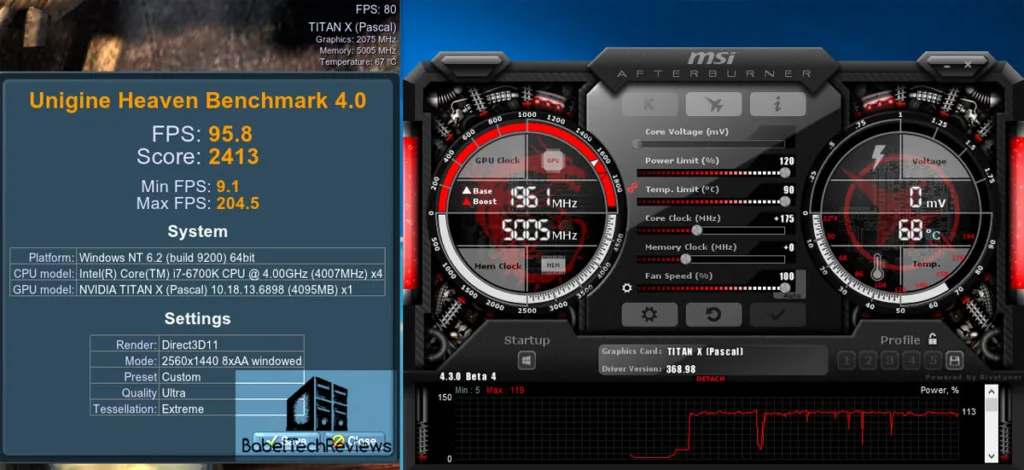
With the fan at 100%, the temperature drops to 68C and we see our highest steady Boost of between 1961MHz to 1974MHz, but the overclock is marginally unstable. At this point we wish we had a voltage adjustment, but it is not yet supported by Afterburner. So we back down the overclock to a +160MHz offset which turned out to be the highest stable overclock that we could achieve with all of our games. 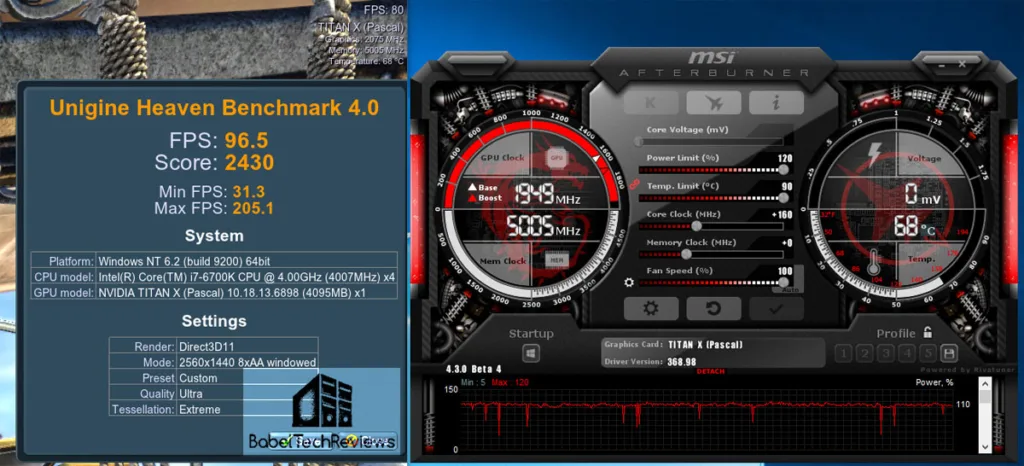
This time, Boost 3.0 reaches 1949MHz and it stays steady through all of our benching with the fan at 100%. We also see that the 15MHz lower overclock below our maximum tested produces a higher Heaven score at +160MHz offset. The fan is loud at this point, but it is more of a “whoosh” of air which is not an irritating whine. We continue to benchmark at 100% fan because we want to have the most consistent results – something that overclockers putting the TITAN X under watercooling will easily achieve. Even turning the fan down to a quieter 75% resulted in minimal throttling to 1923MHz as the temperatures reached 78C.
Pascal likes low core temperatures to achieve its maximum overclock but we were unable to cool our test room below 76F on our warm Summer day. With our core overclock set, we next tried memory overclocking. Here is a +250MHz offset to the memory:
Since we found memory “holes” in the GTX 1080’s GDDRX5 we suspected it may also be happening with the TITAN X. So we lowered our memory overclock to +200MHz offset and found that the performance increased in Heaven 4.0 and with many games that we tested.
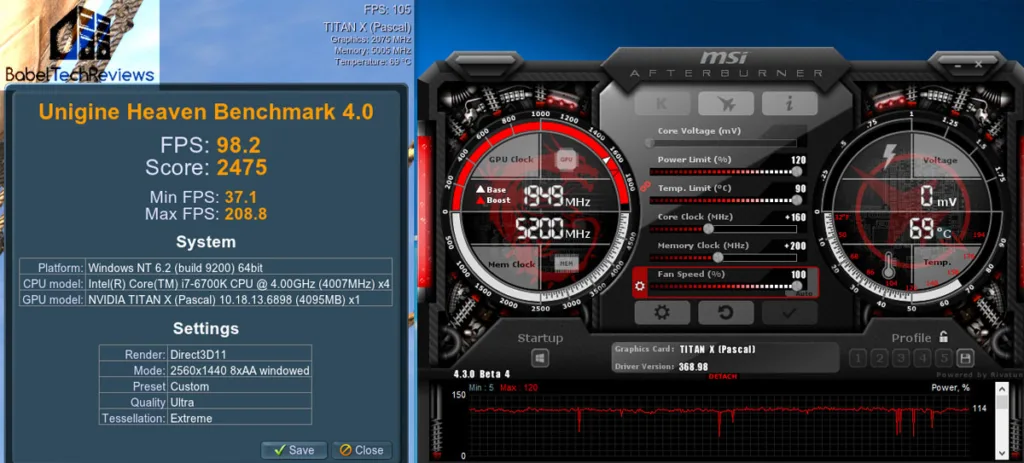 We settled on +200MHz memory clock offset to reach 5200MHz (10400MHz!) and our highest performance in games. Temperatures rose to their maximum 69C but kept the core Boost clock locked in at a very steady 1949MHz with 100% fan speeds. Of course, we tested many other memory overclocks in smaller increments to decide on our final TITAN X overclock of an additional 160MHz to the core and 200MHz to the memory for a steady 1949MHz core and 5200MHz memory.
We settled on +200MHz memory clock offset to reach 5200MHz (10400MHz!) and our highest performance in games. Temperatures rose to their maximum 69C but kept the core Boost clock locked in at a very steady 1949MHz with 100% fan speeds. Of course, we tested many other memory overclocks in smaller increments to decide on our final TITAN X overclock of an additional 160MHz to the core and 200MHz to the memory for a steady 1949MHz core and 5200MHz memory.
We think 1949MHz is a very good steady Boost 3.0 core overclock result considering that we went from originally at 1569MHz Boost with completely stock values to 1746MHz with Power/Temps at maximum. That is a 24.2% increase over completely stock settings and a 11.6% increase over our usual benching with Power/Temps at maximum.
Performance summary charts
Here are the summary charts of 25 games and 2 synthetic tests. The highest settings are always chosen and it is usually DX11. DX12 is picked above DX11 where available, and the settings are ultra or maxed. Specific settings are listed on the performance charts. The benches were run at 2560×1440, 3840×1440, and at 3840×2160.
All results, except for FireStrike and Time Spy, show average framerates and higher is always better. Minimum frame rates are shown next to the averages when they are available, but they are in italics and in a slightly smaller font. In-game settings are fully maxed out and they are identically high or ultra across all platforms. The stock TITAN performance results are in the first column (in black) and the TITAN X overclocked results are shown in the second column (in white). The 3rd column shows the percentage increase from overclocking.
Considering that the TITAN X is overclocked by 11.6% over the stock TITAN X settings (with maximum Power/Temp limits), we see very good scaling in games generally from 6% to 11%, depending on the game and the resolution.
If you don’t want want to overclock your TITAN X at all, we would still suggest setting the Power and Temperature Limits to their maximum for a solid increase over completely stock values with very little differences in fan speeds or noise, and you will get more consistent results without any throttling. And of course, we were unable to set voltages beyond their stock values yet.
Let’s head to our conclusion.
Conclusion:
We would highly recommend overclocking the TITAN X with MSI’s Afterburner. The main thing to remember if want as high an overclock as possible is to cool your room and to set the fan profile to as high as you can enjoy (or to 100%) and to go from there. If you just want significantly higher than Nvidia’s advertised Boost of 1531MHz without overclocking, we would suggest setting Power and Temperature limits to their maximum for a solid increase over completely stock values with very little difference in fan speeds or noise, and you will get more consistent results without any throttling. If you want to save on energy, then Nvidia’s completely stock values are great for good performance and a very quiet fan.
You also need to remember that Pascal overclocking is highly temperature dependent. Keep your GPU cool and you will max out your overclock. Adding voltage is secondary – it only moves the limit up a bit – as the GPU’s BIOS controls it automatically, and it is best used to stabilize a marginal overclock. Unfortunately, no overclocking utility yet supports voltages increases for the TITAN X for the extreme overclockers.
For all the games in our benching suite, overclocking our TITAN X by 11.6% brought noticeable performance gains, sometimes making a practical difference with increased frame rates for fluid performance, especially in borderline situations at the highest resolutions.
We are totally impressed with this top performing Pascal TITAN X chip. Priced at $1200, it is certainly expensive but it stands alone as the world’s fastest gaming GPU. On top of that, it is a hybrid card well suited for Single Precision Compute and for scientific applications.
The TITAN X is an ideal card for 4K and it may well be the first video card to be able to handle maxed out settings at that extreme resolution. There are only a couple of games at 4K where settings might have to be dialed back a bit for a fluid gaming experience, and a WQHD G-SYNC display or a 4K display are perfect complements to the TITAN X.
The Verdict:
- If you want the fastest video card available today, the TITAN X at $1200 is in a class completely by itself, easily topping the performance of the GTX 1080 which was recently the fastest card at $699. It also features decent overclocking ability. However, you may have to wait awhile as the TITAN X is still sold out at Nvidia’s store.
We have a lot of interesting evaluations planned for our readers. We plan to follow up this evaluation with one devoted to overclocking the PowerColor Red Devil RX 470 to its maximum, and we have an EVGA GTX 1060 SC evaluation on the way for publication here next week. And we intend to conclude our TITAN X series with two future evaluations comparing it with GTX 1070 SLI, and also by running compute and deep learning benchmarks.
Happy Gaming!


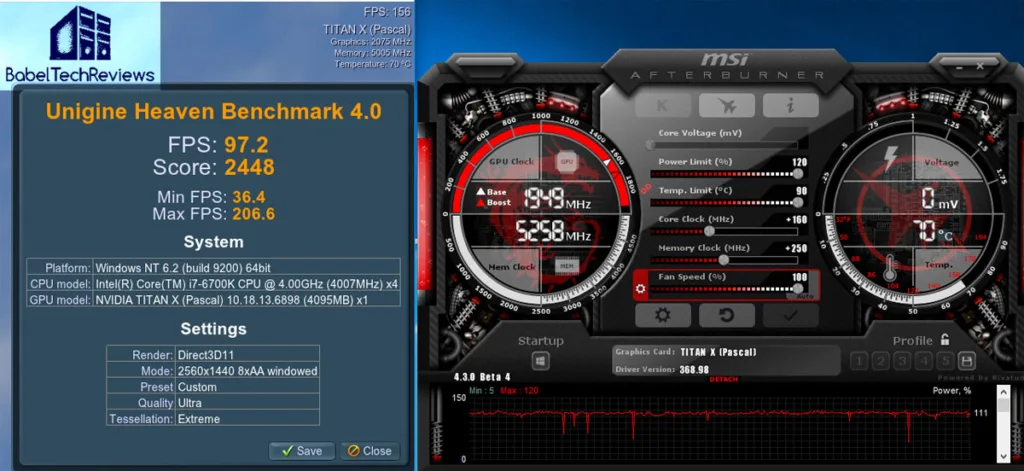
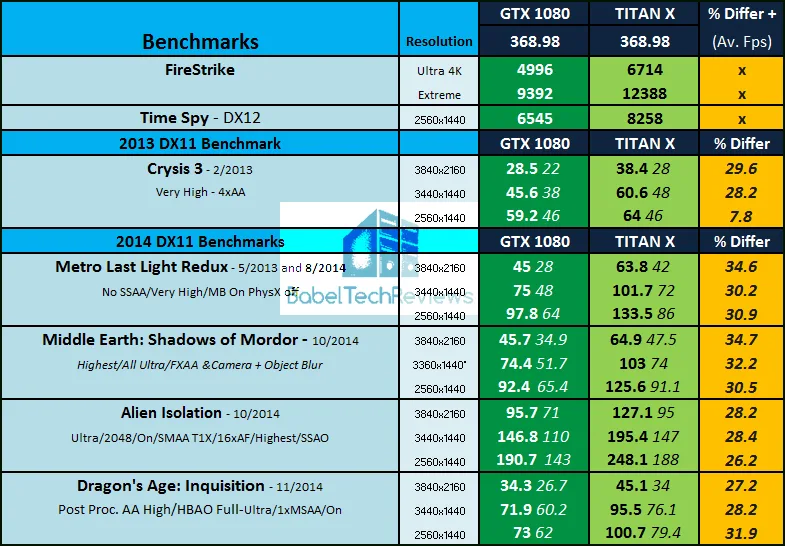
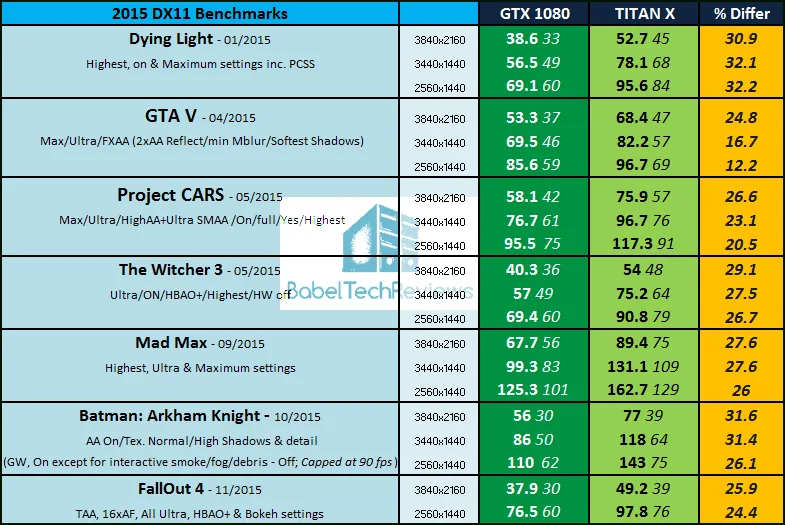
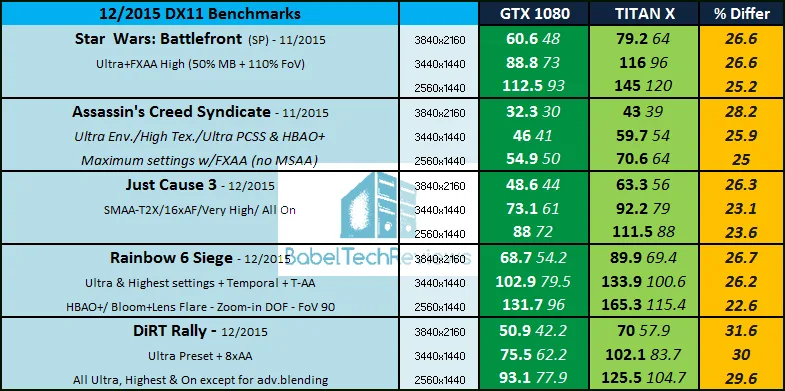
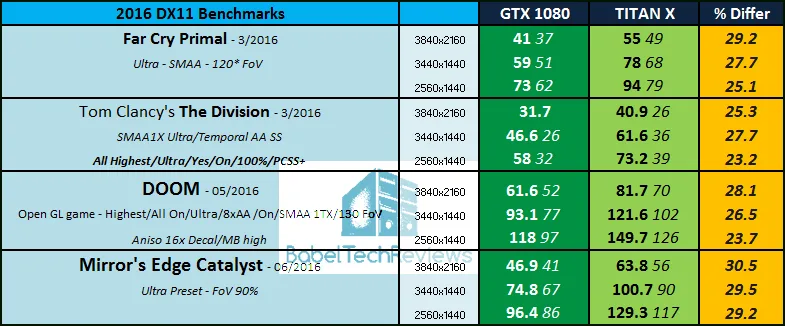
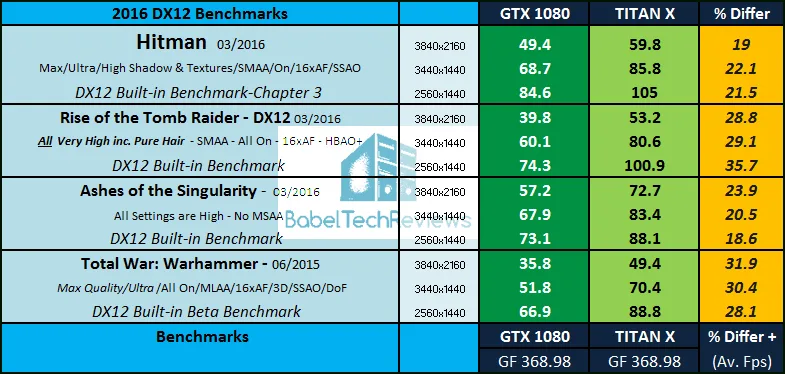
Comments are closed.